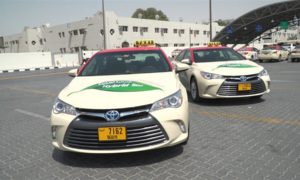UAE’s first hydrogen fuel station was inaugurated in the UAE by Al-Futtaim Motors, Toyota’s exclusive distributor in the UAE, in collaboration with Air Liquide, a major supplier of world’s hydrogen stations in the world. This one-of-a-kind refueling station is located in Dubai Festival City and is intended to be used by Fuel Cell Electric Vehicles (FCEVs).
The new facility comes following the announcement made at the Abu Dhabi Sustainability Week and aims at aiming at drastically lowering CO2 emissions, in line with the UAE Vision 2021. The new Al Badia-based hydrogen station will enable larger-scale deployment of Fuel Cell Electric Vehicles as part of a pilot program which started in May 2017, aiming at testing the zero-emission FCEV technology on UAE roads.
Using cutting-edge technologies, such as Toyota’s proven electric propulsion system also available in hybrid cars, FCEVs such as the Toyota Mirai – a compact sedan showcased at the event – run on hydrogen emitting only water from the tail pipe. In the onboard Fuel Cell Stack, hydrogen combines with oxygen in the air to generate electricity that powers the vehicle’s electric motor.
Unlike battery-powered electric vehicles, the Toyota Mirai performs similar to traditional petrol engine cars. It does not require external electric charging, can be refilled with hydrogen in less than 5 minutes – which is much quicker than the couple of hours it takes to fully charge an Electric Vehicle (EV) – and is able to travel up to 500km+ on a full tank.
Although the Toyota Mirai won’t be available in the UAE any time soon, in the markets such as the US where it is available, it is priced closer to 60,000 USD, which is almost twice that of a Toyota Prius and three times that of a Corolla . But if you were to apply the economy of scale, it may turn out to be cheaper to run and most definitely be more eco-friendly than its siblings. And when that happens the Fuel Cell Electric technology has the potential to significantly reduce the UAE’s dependence on oil and lower car-generated CO2 emissions.


















